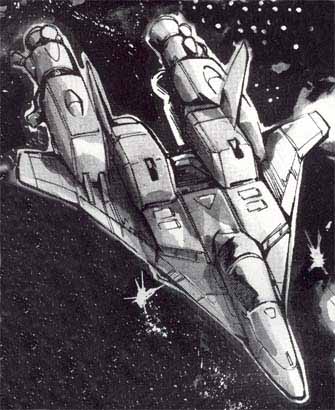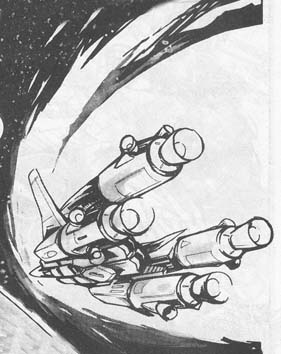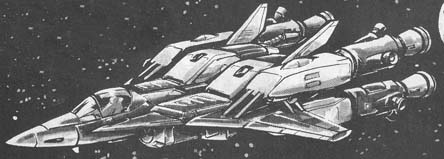

With the introduction of the VF-6 “Alpha” fighter in 2019, the Earth Defense Forces had a formidable fighter to replace the aging VF-1 and VF-4 series of veritechs. If there was a single weakness to the VF-6, it was the lack of fuel for spaceborne operations. In order to rectify this problem the United Earth Government, ordered several booster concepts which would attach to the rear of the VF-6 and provide additional fuel and firepower while the unit was in space. Several design concepts were considered; however, the most promising was the TREAD booster that attached directly to the rear of the VF-6 and could boost the VF-6 into orbit. The TREAD booster program was eventually merged with the VF-X-7 heavy assault variable fighter. Unfortunately, two years of testing proved that the technology for the VF-X-7 “Beta” fighter was still premature and the project was canceled and the TREAD concept was revived. By 2022 approximately 400 TREAD units had been completed; however, the cost of producing a TREAD proved to be extremely high as the booster itself was as complicated as some contemporary space superiority fighters. As most of the TREAD units were to be deployed with the REF, the remaining Earth based Armies of the Southern Cross (ASC) and Robotech Defense Forces (RDF) still needed a space booster which could raise operational range of the VF-6 to near that of the VF-1 and VF-4 units which were rapidly reaching the end of their operational lifetime and in desperate need of replacement. The ASC was so disappointed with the range of the VF-6 and lack of an immediate alternative that they decided in 2022 to develop their own series of veritechs and deploy ASC VF-6 “Alphas” in atmospheric operations only.
Military engineers for the RDF and REF decided to combine their expertise and develop an inexpensive booster for the VF-6. Design of the NP-BP-22 model FAST pack was finalized after only six months and greatly improved the combat radius of the VF-6. The design is reminiscent of the FAST PACK boosters for the VF-1; however, the VF-6 would mount four of the boosters units mounted in over/under mounts on each wing which does provide the VF-6 with tremendous thrust and fuel reserves, but does not allow the mecha to transform out of fighter mode while the boosters are attached. The primary engine for each booster is a single Pratt & Whitney +EF-2020 providing 250 kN of primary thrust. Each engine is fueled with 6,000 liters of D20 and with all four boosters a fully armed and fueled VF-6 has a maximum range of nearly 24 kps. To augment the firepower of the VF-6 while in fighter mode, each of the boosters have a MM-24 multi-missile system mounted on the front. Each launcher has twenty-four short range hammerhead missiles which can fire from four tubes on either side of the booster. Unfortunately, the inner launchers are partially blocked by the VF-6 structure and any missiles exiting those ports could hit the rear of the Alpha fighter. As a result, each booster can safely fire missiles in volleys of two; however in desperate situations, the pilot can override the safeties on the launcher and fire missiles from the inner two missile launching ports albeit at some risk to himself and the mecha.
The NP-BP-22 boosters were first delivered to the REF in October 2022 with approximately 2,000 booster units ultimately produced before the REF's departure in December of 2022. The introduction to the RDF occurred later that same year; however, with the departure of the REF the RDF was placed in a secondary role without a well-defined mission to the ASC which had already decided to replace the early model VF-6 veritechs with their own VF-8 “Logans” and VFH-10 ”AGACS”. In the years leading up to the 2nd Robotech War, the RDF stockpiled VF-6 veritechs and booster units on lunar depots. The RDF largely stayed out of space combat during the 2nd Robotech War and therefore booster mounted VF-6 did not see large-scale action at that time. At the conclusion of the 2nd Robotech War, the depots were resupplied albeit at a much-reduced rate.
The first and only large-scale deployment of the NP-BP-22 boosters occurred after the Invid invasion of Earth. By 2031 nearly 2,000 VF-6 fighters were deployed on the moon. RDF commanders in an effort to destroy the initial Invid beachhead on Earth launched a massive combined assault with Earth resistance groups. As few united Earth Forces capital ships survived the initial assault, the Lunar attack squadrons of Alpha fighters used NP-BP-22 boosters, in addition to larger FP-BP-01 multi-ship boosters, to travel between the moon to Earth. Unfortunately, the assault failed and less than 100 units escaped the Invid counter attack.
Meanwhile in deep space, the REF would use the NP-BP-22 on a more limited scale. For a majority of spaceborne operations REF capital ships would transport their VF-6 combat squadrons and engage the Invid either in low orbit or within several hundred kilometers of their base ships. However, REF Special Forces or long-range reconnaissance squadrons used the NP-BP-22 booster units on a regular basis. The NP-BP-22 was placed into a reserve role with the introduction of the VFB-12 “Beta” fighter, which provided similar fuel capabilities with the added benefit that the booster was now a heavy assault variable fighter and saw little action after 2039.
MDC BY LOCATION:
| Location | VF-6 BOOSTER |
| Forward Missile Pod | 100 |
| (1) Main Body Booster | 100 |
| Main Thruster | 50 |
| Auxiliary Thrusters (2) | 35 |
NOTES:
 SPEEDS:
SPEEDS: NP-BP-12 MM-24
FAST PACK MULTI-MISSILE SYSTEM: Mounted on the front of each of FAST packs
is a single MM-24 multi-missile system. Each launcher can hold
twenty-four
hammerhead short range missiles. Unfortunately, the inner launchers
are partially blocked by the VF-6 structure and any missiles exiting those
ports could hit the rear of the Alpha fighter. As a result, each booster can
safely fire missiles in volleys of two; however, the pilot can override the
safeties on the launcher and fire missiles from the inner two missile
launching ports. Pilots usually viewed the boosters as more of a
hindrance forcing them to remain in fighter mode and would often fire one or
two missile volleys when contact was made with the enemy and then quickly
eject the boosters to allow the VF-6 full use of both guardian and battloid
configurations.
NP-BP-12 MM-24
FAST PACK MULTI-MISSILE SYSTEM: Mounted on the front of each of FAST packs
is a single MM-24 multi-missile system. Each launcher can hold
twenty-four
hammerhead short range missiles. Unfortunately, the inner launchers
are partially blocked by the VF-6 structure and any missiles exiting those
ports could hit the rear of the Alpha fighter. As a result, each booster can
safely fire missiles in volleys of two; however, the pilot can override the
safeties on the launcher and fire missiles from the inner two missile
launching ports. Pilots usually viewed the boosters as more of a
hindrance forcing them to remain in fighter mode and would often fire one or
two missile volleys when contact was made with the enemy and then quickly
eject the boosters to allow the VF-6 full use of both guardian and battloid
configurations.Random Hit Locations
When there is an equal chance of hitting both sides from 1D6
When there is a preferred side, roll 1D10
| Alpha Fighter with Boosters |
FRONT |
BACK |
SIDES |
TOP |
BOTTOM |
| Head (Main Body) | 01 | - | 01 | - | 01-02 |
| Sensor Head (Main Body) | - | - | - | - | - |
| Hands (Forearms) | - | 01-02 | - | - | - |
| Forearms (Shoulders) | 02-05 | 03-20 | 03-08 | 01-10 | - |
| Shoulders (Main Body) | 06-20 | 21-25 | 09-14 | 11-18 | - |
| Upper Legs (Main Body) | 21-30 | 26-30 | 15-20 | - | 03-15 |
| Lower Legs (Upper Legs) | 31-35 | 31-40 | 21-25 | - | 16-21 |
| Wings (Main Body) | 36-40 | 41-45 | 26-30 | 19-40 | 22-40 |
| Tail (Main Body) | 41-43 | 46-47 | 31-34 | 41-43 | - |
| Main Body | 44-60 | 48-60 | 35-50 | 44-65 | 41-60 |
| Pilot's Compartment | 61-75 | 61-65 | 51-65 | 66-75 | 61-70 |
| Gun Pod (Hands) | 76-78 | 66-67 | 66-67 | - | 71-75 |
| Booster Missile Pod (Wing) | 79-90 | 68-72 | 68-80 | 76-85 | 76-82 |
| Main Body Booster (Booster Missile Pod) | 91-95 | 73-80 | 81-95 | 86-95 | 83-95 |
| Main Booster Thruster (Main Body Booster) | 96-97 | 81-96 | 96-98 | 96-98 | 96-98 |
| Auxiliary Booster Thruster (Main Body Booster) | 98-00 | 97-00 | 99-00 | 99-00 | 99-00 |